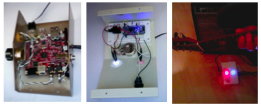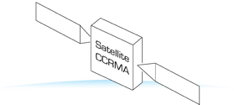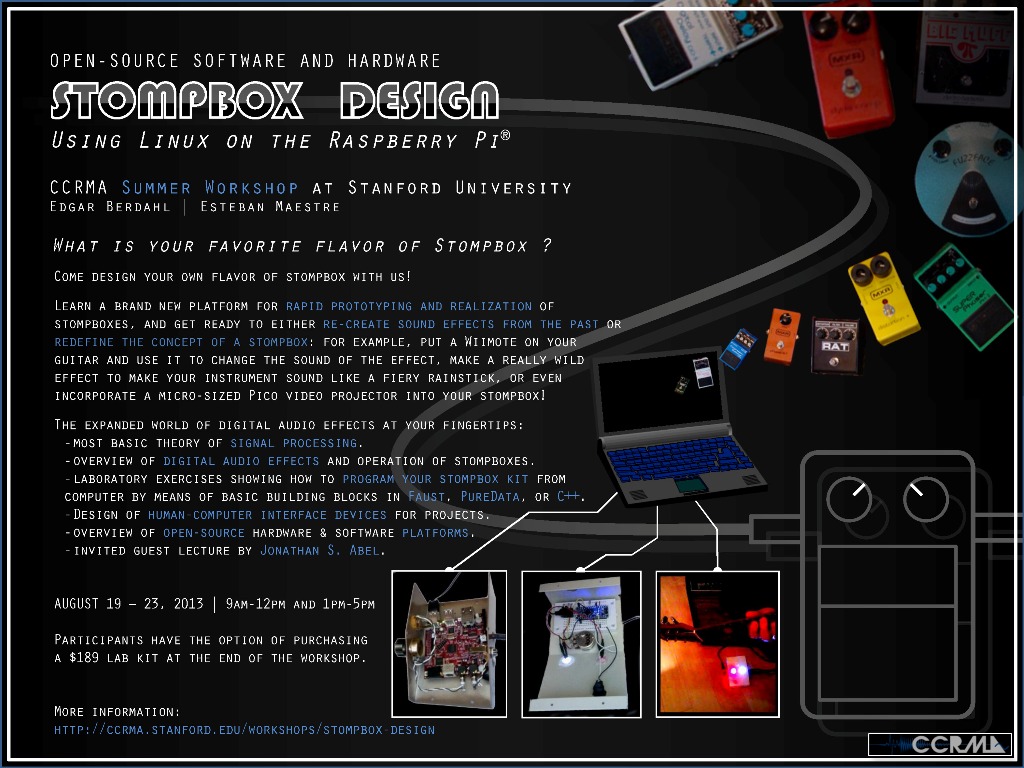Difference between revisions of "Stompbox 2013"
m (replaced flyer) |
(Updated materials (slides pdf + pd patches) and respective links. Added various paragraphs. Revised overall look, margins etc.) |
||
| Line 6: | Line 6: | ||
[[Image:WorkshopFXPixSmall.jpg]] | [[Image:WorkshopFXPixSmall.jpg]] | ||
| + | |||
==COURSE HISTORY AND DESCRIPTION== | ==COURSE HISTORY AND DESCRIPTION== | ||
| − | + | Come design your own flavor of stompbox at Stanford Universityʼs Stompbox Design workshop. We will teach you a brand new platform for implementing stompboxes that not only enables you to create any sound effects from the past but also promotes the creation of new sound effects. Our resources for new media design are also at your fingertips if you would like to re-design the concept of a guitar stompbox: for example, put a Wiimote on your guitar and use it to change the sound of the effect, or use some LEDs to simulate the glow of vacuum tubes, or even incorporate a micro-sized Pico projector into your stompbox! The expanded world of digital audio effects is at your fingertips because the workshop incorporates: | |
* Most basic theory of signal processing | * Most basic theory of signal processing | ||
* Description of operation of prior stompboxes and digital audio effects | * Description of operation of prior stompboxes and digital audio effects | ||
| Line 22: | Line 23: | ||
Further discussion of open-source hardware and software platforms including Satellite CCRMA. Finally, we will round out the workshop with a roundtable presentation of the stompboxes you create followed by an optional evening jam session for fun. | Further discussion of open-source hardware and software platforms including Satellite CCRMA. Finally, we will round out the workshop with a roundtable presentation of the stompboxes you create followed by an optional evening jam session for fun. | ||
| − | This workshop is intended for: | + | |
| + | This workshop is intended for: | ||
| + | |||
Musicians interested in exploring new possibilities in digital audio effects in a hands-on and technical way; Makers, engineers, computer scientists, or product designers interested in exploring artistic outlets for their talents and collaborating with musicians; and/or anyone looking to gain valuable skills in basic audio signal processing and human-computer interfaces, with a focus on invention. Participants are encouraged (but by no means required) to bring their own laptop computers and/or musical instruments. | Musicians interested in exploring new possibilities in digital audio effects in a hands-on and technical way; Makers, engineers, computer scientists, or product designers interested in exploring artistic outlets for their talents and collaborating with musicians; and/or anyone looking to gain valuable skills in basic audio signal processing and human-computer interfaces, with a focus on invention. Participants are encouraged (but by no means required) to bring their own laptop computers and/or musical instruments. | ||
| Line 28: | Line 31: | ||
How to [https://ccrma.stanford.edu/workshops/stompbox-design sign up] for the workshop! | How to [https://ccrma.stanford.edu/workshops/stompbox-design sign up] for the workshop! | ||
| + | |||
| + | |||
==COURSE SCHEDULE == | ==COURSE SCHEDULE == | ||
| Line 48: | Line 53: | ||
|Friday || Work on project || [[Project presentations]] 3-4:30PM | |Friday || Work on project || [[Project presentations]] 3-4:30PM | ||
|} | |} | ||
| + | |||
| + | |||
==FX Basics LECTURES== | ==FX Basics LECTURES== | ||
| + | In this section we provide linkes to the FX Basics lectures we'll go through during the week, and complementary materials. | ||
| + | Because of the limited time for this workshop as compared to the amount of theory and literature behind digital audio effects and implementation issues, the contents of these lectures are limited to introducing the very basics of some of the most popular types of audio effects used in stompboxes. For a deeper coverage of signal processing techniques behind digital audio effects, please refer to the CCRMA courses listed below (in the References section) and their complementary materials or books. | ||
| + | '''MONDAY''' | ||
| − | + | FX Introductory lectures: | |
| − | + | [http://ccrma.stanford.edu/~esteban/stompbox/2013/2013_StompboxDesign_1_Introduction.pdf Fx Basics 1: Introduction] | |
| − | [http://ccrma.stanford.edu/~esteban/stompbox/ | + | [http://ccrma.stanford.edu/~esteban/stompbox/2013/2013_StompboxDesign_2_Dynamics.pdf Fx Basics 2: Dynamics Effects] |
| − | |||
| − | + | Basic PureData demo patches: | |
| − | http://ccrma.stanford.edu/~esteban/stompbox/ | + | [http://ccrma.stanford.edu/~esteban/stompbox/2013/pd/00_stomp_dynamics_1.pd Boost] |
| − | http://ccrma.stanford.edu/~esteban/stompbox/ | + | [http://ccrma.stanford.edu/~esteban/stompbox/2013/pd/01_stomp_dynamics_2.pd Tremolo] |
| − | http://ccrma.stanford.edu/~esteban/stompbox/ | + | [http://ccrma.stanford.edu/~esteban/stompbox/2013/pd/02_stomp_dynamics_3.pd Noise gate] |
| − | http://ccrma.stanford.edu/~esteban/stompbox/ | + | [http://ccrma.stanford.edu/~esteban/stompbox/2013/pd/03_stomp_dynamics_4.pd Compressor] |
| − | + | Bear in mind that these Pure Data patches were created to illustrate the basic principles of some elementary digital audio effects. For that purpose, some graphical displays were added as a visual complement to monitor some (control) signals. Remember that, although potentially useful for debugging/monitoring purposes, those graphical displays (i.e. the '''[table]''' objects) do not contribute to sound processing. However, they may cause the Raspberry Pi to run very slow, so it's good to remove them (together with the corresponding '''[tabwrite~]''' objects)! | |
| + | Lab resources: | ||
| + | |||
| + | [http://en.flossmanuals.net/pure-data/ch072_introduction/ Categorized list of Pd Objects] | ||
| + | (on a single page [http://protman.com/content/list-puredata-objects-and-extended-objects here]) | ||
| + | |||
| + | [http://ccrma.stanford.edu/~esteban/stompbox/solo_man.wav Ugly guitar track 'solo_man.wav'] | ||
| + | |||
| + | [http://ccrma.stanford.edu/~carlsonc/DryGuitarTracks.zip Nicer guitar tracks] Courtesy of Jonathan Abel, please do not distribute. | ||
| + | |||
| + | |||
| + | |||
| + | '''TUESDAY''' | ||
| − | + | FX Introductory lecture: | |
| − | + | [http://ccrma.stanford.edu/~esteban/stompbox/2013/2013_StompboxDesign_3_Filtering.pdf Fx Basics 3: Filtering] | |
| − | |||
| + | Basic PureData demo patches: | ||
| − | + | [http://ccrma.stanford.edu/~esteban/stompbox/2013/pd/04_stomp_filtering_1.pd Biquad block example] | |
| − | http://ccrma.stanford.edu/~esteban/stompbox/ | + | [http://ccrma.stanford.edu/~esteban/stompbox/2013/pd/05_stomp_filtering_2.pd Wah example] |
| − | |||
Lab resources: | Lab resources: | ||
| − | [http:// | + | [http://ccrma.stanford.edu/~esteban/stompbox/2013/pd/filters_by_mmb.zip filters_by_mmb.zip] Basic Pd filtering library by Mike Moser-Booth - Latest version (not checked) of the above library can be found at https://github.com/dotmmb/mmb . |
| − | ( | + | |
| − | http://ccrma.stanford.edu/~esteban/stompbox/ | + | [http://ccrma.stanford.edu/~esteban/stompbox/2013/pd/filters_by_mmb.txt filters_by_mmb.txt] Short intro on why and how we use the above library] |
| + | Extra material: | ||
| − | + | [http://ccrma.stanford.edu/~esteban/stompbox/2012/2012_11_stomp_wah_model.pd Cry baby wah model] | |
| − | |||
| − | |||
| − | |||
| − | + | '''WEDNESDAY''' | |
| + | FX Introductory lecture: | ||
| + | [http://ccrma.stanford.edu/~esteban/stompbox/2013/2013_StompboxDesign_FXBasics_4_Distortion.pdf Fx Basics 4: Distortion] | ||
| − | |||
| − | + | Basic PureData demo patch: | |
| − | [http://ccrma.stanford.edu/~esteban/stompbox/ | + | [http://ccrma.stanford.edu/~esteban/stompbox/pd/06_stomp_distortion.pd Distortion / Fuzz] |
| − | |||
| − | |||
| − | + | '''THURSDAY''' | |
| − | + | FX Introductory lecture: | |
| − | http://ccrma.stanford.edu/~esteban/stompbox/ | + | [http://ccrma.stanford.edu/~esteban/stompbox/2013/2013_StompboxDesign_FXBasics_5_Time.pdf Fx Basics 5: Time Effects] |
| − | [http://ccrma.stanford.edu/~ | + | Basic PureData demo patches: |
| + | |||
| + | [http://ccrma.stanford.edu/~esteban/stompbox/07_stomp_time_1.pd Simple delay] | ||
| + | |||
| + | [http://ccrma.stanford.edu/~esteban/stompbox/08_stomp_time_2.pd Simple tapped delay] | ||
| + | |||
| + | [http://ccrma.stanford.edu/~esteban/stompbox/09_stomp_time_3.pd Feedback Delay] | ||
| + | |||
| + | [http://ccrma.stanford.edu/~esteban/stompbox/10_stomp_time_4.pd Flanger] | ||
| + | |||
| + | |||
| + | |||
| + | '''FRIDAY''' | ||
| + | |||
| + | (No lectures on Friday) | ||
| − | |||
| − | |||
==WORKSHOP PROJECT== | ==WORKSHOP PROJECT== | ||
| Line 138: | Line 166: | ||
| + | ==RELATED LECTURES== | ||
| − | |||
*[[PID Introduction]] | *[[PID Introduction]] | ||
*[[Survey of Physical Interfaces for Music]] | *[[Survey of Physical Interfaces for Music]] | ||
| Line 146: | Line 174: | ||
*[[Microcontroller Architecture]] | *[[Microcontroller Architecture]] | ||
*[[Interaction Design Framework]] | *[[Interaction Design Framework]] | ||
| + | |||
| + | |||
==LABS== | ==LABS== | ||
(see links in course schedule) | (see links in course schedule) | ||
| + | |||
| + | |||
==SOFTWARE== | ==SOFTWARE== | ||
| + | |||
* The lectures will primarily be in [http://puredata.info/downloads Pure Data (Pd) Extended] for sound synthesis. We will introduce some other alternatives such as writing plug-ins directly in C/C++ or with Faust. | * The lectures will primarily be in [http://puredata.info/downloads Pure Data (Pd) Extended] for sound synthesis. We will introduce some other alternatives such as writing plug-ins directly in C/C++ or with Faust. | ||
* The micro SDHC card for your kit will be initialized with [http://ccrma.stanford.edu/~eberdahl/Satellite Satellite CCRMA] so that you can get up and running instantly. | * The micro SDHC card for your kit will be initialized with [http://ccrma.stanford.edu/~eberdahl/Satellite Satellite CCRMA] so that you can get up and running instantly. | ||
* The [http://www.raspberrypi.org/ Raspberry Pi] platform enables linux to run on a high-power 700MHz CPU. It can execute floating point operations natively, which is essential for rapid prototyping of audio algorithms. | * The [http://www.raspberrypi.org/ Raspberry Pi] platform enables linux to run on a high-power 700MHz CPU. It can execute floating point operations natively, which is essential for rapid prototyping of audio algorithms. | ||
* The [http://arduino.cc/en/Main/Software Arduino software] could be used to change the [http://firmata.org Firmata-based] firmware that gets data from the Arduino Nano board into Pd. | * The [http://arduino.cc/en/Main/Software Arduino software] could be used to change the [http://firmata.org Firmata-based] firmware that gets data from the Arduino Nano board into Pd. | ||
| + | |||
| + | |||
==REFERENCES== | ==REFERENCES== | ||
| + | |||
* [[MaxLab]] | * [[MaxLab]] | ||
* [[PID Links]] | * [[PID Links]] | ||
| Line 170: | Line 206: | ||
* [http://ccrma.stanford.edu/~eberdahl/Satellite Satellite CCRMA] | * [http://ccrma.stanford.edu/~eberdahl/Satellite Satellite CCRMA] | ||
[[Image:SatelliteCCRMALogoVSmall.jpg]] | [[Image:SatelliteCCRMALogoVSmall.jpg]] | ||
| + | |||
| + | |||
==FAQ== | ==FAQ== | ||
| + | |||
'''Project questions''' | '''Project questions''' | ||
Revision as of 15:22, 8 August 2013
Stompbox Design Workshop
CCRMA Summer Workshop 2013
August 19-23
Instructors: Edgar Berdahl eberdahl@ccrma.stanford.edu and Esteban Maestre esteban@ccrma.Stanford.EDU
Contents
COURSE HISTORY AND DESCRIPTION
Come design your own flavor of stompbox at Stanford Universityʼs Stompbox Design workshop. We will teach you a brand new platform for implementing stompboxes that not only enables you to create any sound effects from the past but also promotes the creation of new sound effects. Our resources for new media design are also at your fingertips if you would like to re-design the concept of a guitar stompbox: for example, put a Wiimote on your guitar and use it to change the sound of the effect, or use some LEDs to simulate the glow of vacuum tubes, or even incorporate a micro-sized Pico projector into your stompbox! The expanded world of digital audio effects is at your fingertips because the workshop incorporates:
- Most basic theory of signal processing
- Description of operation of prior stompboxes and digital audio effects
- Laboratory exercise teaching you how to program our own open-source software and hardware platform involving:
- connecting to your stompbox over an Ethernet connection from your laptop
- creating new digital audio effects by connecting together basic building blocks in the graphical
- programming language Pure Data
- building simple button and knob interfaces to Pure Data
- How to program digital audio effects in C++ and/or Faust
- Introduction to human-computer interface devices for projects
Further discussion of open-source hardware and software platforms including Satellite CCRMA. Finally, we will round out the workshop with a roundtable presentation of the stompboxes you create followed by an optional evening jam session for fun.
This workshop is intended for:
Musicians interested in exploring new possibilities in digital audio effects in a hands-on and technical way; Makers, engineers, computer scientists, or product designers interested in exploring artistic outlets for their talents and collaborating with musicians; and/or anyone looking to gain valuable skills in basic audio signal processing and human-computer interfaces, with a focus on invention. Participants are encouraged (but by no means required) to bring their own laptop computers and/or musical instruments.
This workshop was created by Edgar Berdahl and Esteban Maestre in 2011. This workshop uses very similar hardware to the New Music Controllers workshop, but the focus is more on applications to stompbox design and audio signal processing.
How to sign up for the workshop!
COURSE SCHEDULE
We will meet from 9am-5:00pm daily, with mini-breaks at 10:30 and 3:00, and a lunch break from 12-1.
| Date | Morning (9am-12noon) | Afternoon (1:00pm-5:00pm) |
| Monday | Introduction, Overview, Pd basics lecture (incl. one digital effect example), Kit How-To, Lab 0: Making Sound With Pd | Review Lab 0, FX Lecture, Lab 1: Making FX In Pd |
| Tuesday | Review Lab 1, FX Lecture, Introduction to Electronics--Sensors1 | Lab 2: Controlling an Effect with Real Sensors |
| Wednesday | Lab 2 Review, Interfacing With The Rest Of The World (i.e. making cables, etc.) | FX Lecture, Optional guided laboratory time or start on project |
| Thursday | FX Lecture, Refine project ideas, Work on project, Discuss enclosures | J. Abel Guest lecture, Special topics, Work on project |
| Friday | Work on project | Project presentations 3-4:30PM |
FX Basics LECTURES
In this section we provide linkes to the FX Basics lectures we'll go through during the week, and complementary materials. Because of the limited time for this workshop as compared to the amount of theory and literature behind digital audio effects and implementation issues, the contents of these lectures are limited to introducing the very basics of some of the most popular types of audio effects used in stompboxes. For a deeper coverage of signal processing techniques behind digital audio effects, please refer to the CCRMA courses listed below (in the References section) and their complementary materials or books.
MONDAY
FX Introductory lectures:
Basic PureData demo patches:
Bear in mind that these Pure Data patches were created to illustrate the basic principles of some elementary digital audio effects. For that purpose, some graphical displays were added as a visual complement to monitor some (control) signals. Remember that, although potentially useful for debugging/monitoring purposes, those graphical displays (i.e. the [table] objects) do not contribute to sound processing. However, they may cause the Raspberry Pi to run very slow, so it's good to remove them (together with the corresponding [tabwrite~] objects)!
Lab resources:
Categorized list of Pd Objects (on a single page here)
Ugly guitar track 'solo_man.wav'
Nicer guitar tracks Courtesy of Jonathan Abel, please do not distribute.
TUESDAY
FX Introductory lecture:
Basic PureData demo patches:
Lab resources:
filters_by_mmb.zip Basic Pd filtering library by Mike Moser-Booth - Latest version (not checked) of the above library can be found at https://github.com/dotmmb/mmb .
filters_by_mmb.txt Short intro on why and how we use the above library]
Extra material:
WEDNESDAY
FX Introductory lecture:
Basic PureData demo patch:
THURSDAY
FX Introductory lecture:
Basic PureData demo patches:
FRIDAY
(No lectures on Friday)
WORKSHOP PROJECT
One of the goals of this workshop is to help you get hands-on experience building a novel stompbox project of your choosing. You are encouraged to work with other workshop participants on the project, particularly those who might have skills that complement your own. Since the workshop is short, it is a good idea to start thinking of ideas during the first lectures and labs; during the second half of the workshop, you will primarily be working on getting a "demo-able" prototype ready for the project presentations on Friday afternoon.
RELATED LECTURES
- PID Introduction
- Survey of Physical Interfaces for Music
- Introduction to Electronics
- Sensors
- Microcontroller Architecture
- Interaction Design Framework
LABS
(see links in course schedule)
SOFTWARE
- The lectures will primarily be in Pure Data (Pd) Extended for sound synthesis. We will introduce some other alternatives such as writing plug-ins directly in C/C++ or with Faust.
- The micro SDHC card for your kit will be initialized with Satellite CCRMA so that you can get up and running instantly.
- The Raspberry Pi platform enables linux to run on a high-power 700MHz CPU. It can execute floating point operations natively, which is essential for rapid prototyping of audio algorithms.
- The Arduino software could be used to change the Firmata-based firmware that gets data from the Arduino Nano board into Pd.
REFERENCES
- MaxLab
- PID Links
- Pure Data (Pd) Extended
- Raspberry Pi
- Arduino software
- Firmata
- Faust
- Course: Introduction to Digital Audio Signal Processing
- Course: Signal Processing Effects for Digital Audio Effects
FAQ
Project questions
- Can I do ____ for my project?
You can do whatever you would like for your project. Keep in mind that you really only have a few days to work on it, so you might want to focus on one crucial aspect of a larger project that you'd like to have working.
- Can I incorporate my own hardware and software into my project?
Yes, you can, although we have limited time and ability to support hardware and software other than what is introduced in the labs.
- Can I keep the tools we use during the workshop?
If you buy the kit!


